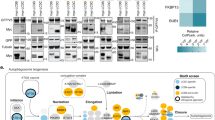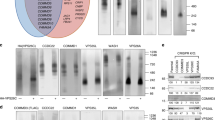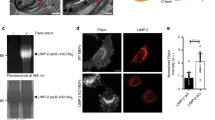Abstract
Loss of the human mucolipin-1 gene underlies mucolipidosis type IV (MLIV), a lysosomal storage disease that results in severe developmental neuropathology1,2,3. Unlike other lysosomal storage diseases, MLIV is not associated with a lack of lysosomal hydrolases4; instead, MLIV cells display abnormal endocytosis of lipids and accumulate large vesicles, indicating that a defect in endocytosis may underlie the disease4,5,6. Here we report the identification of a loss-of-function mutation in the Caenorhabditis elegans mucolipin-1 homolog, cup-5, and show that this mutation results in an enhanced rate of uptake of fluid-phase markers, decreased degradation of endocytosed protein and accumulation of large vacuoles. Overexpression of cup-5(+) causes the opposite phenotype, indicating that cup-5 activity controls aspects of endocytosis. Studies in model organisms such as C. elegans have helped illuminate fundamental mechanisms involved in normal cellular function and human disease; thus the C. elegans cup-5 mutant may be a useful model for studying conserved aspects of mucolipin-1 structure and function and for assessing the effects of potential therapeutic compounds.
This is a preview of subscription content, access via your institution
Access options
Subscribe to this journal
Receive 12 print issues and online access
$209.00 per year
only $17.42 per issue
Buy this article
- Purchase on Springer Link
- Instant access to full article PDF
Prices may be subject to local taxes which are calculated during checkout






Similar content being viewed by others
References
Bargal, R. et al. Identification of the gene causing mucolipidosis type IV. Nature Genet. 26, 118–123 (2000).
Bassi, M.T. et al. Cloning of the gene encoding a novel integral membrane protein, mucolipidin-and identification of the two major founder mutations causing mucolipidosis type IV. Am. J. Hum. Genet. 67, 1110–1120 (2000).
Sun, M. et al. Mucolipidosis type IV is caused by mutations in a gene encoding a novel transient receptor potential channel. Hum. Mol. Genet. 9, 2471–2478 (2000).
Merin, S., Livni, N., Berman, E.R. & Yatziv, S. Mucolipidosis IV: ocular, systemic, and ultrastructural findings. Invest. Ophthalmol. 14, 437–448 (1975).
Bargal, R. & Bach, G. Mucolipidosis type IV: abnormal transport of lipids to lysosomes. J. Inherit. Metab. Dis. 20, 625–632 (1997).
Chen, C.S., Bach, G. & Pagano, R.E. Abnormal transport along the lysosomal pathway in mucolipidosis, type IV disease. Proc. Natl. Acad. Sci. USA 95, 6373–6378 (1998).
Chalfie, M., Tu, Y., Euskirchen, G., Ward, W.W. & Prasher, D.C. Green fluorescent protein as a marker for gene expression. Science 263, 802–805 (1994).
Fire, A. et al. Potent and specific genetic interference by double-stranded RNA in Caenorhabditis elegans. Nature 391, 806–811 (1998).
Eeckman, F.H. & Durbin, R. ACeDB and macace. Methods Cell Biol. 48, 583–605 (1995).
Altschul, S.F., Gish, W., Miller, W., Myers, E.W. & Lipman, D.J. Basic local alignment search tool. J. Mol. Biol. 215, 403–410 (1990).
Mu, F.T. et al. EEA1, an early endosome-associated protein. EEA1 is a conserved α-helical peripheral membrane protein flanked by cysteine “fingers” and contains a calmodulin-binding IQ motif. J. Biol. Chem. 270, 13503–13511 (1995).
Zhang, Y., Grant, B. & Hirsh, D. RME-8, a conserved J-domain protein, is required in endocytosis in C. elegans. Mol. Biol. Cell (in press).
Peters, C. et al. Trans-complex formation by proteolipid channels in the terminal phase of membrane fusion. Nature 409, 581–588 (2001).
Zeigler, M., Bargal, R., Suri, V., Meidan, B. & Bach, G. Mucolipidosis type IV: accumulation of phospholipids and gangliosides in cultured amniotic cells. A tool for prenatal diagnosis. Prenat. Diagn. 12, 1037–1042 (1992).
Brenner, S. The genetics of Caenorhabditis elegans. Genetics 77, 71–94 (1974).
Jakubowski, J. & Kornfeld, K. A local, high-density, single-nucleotide polymorphism map used to clone Caenorhabditis elegans cdf-1. Genetics 153, 743–752 (1999).
Mello, C.C., Kramer, J.M., Stinchcomb, D. & Ambros, V. Efficient gene transfer in C. elegans: extrachromosomal maintenance and integration of transforming sequences. EMBO J. 10, 3959–3970 (1991).
Han, M. & Sternberg, P.W. Analysis of dominant-negative mutations of the Caenorhabditis elegans let-60 ras gene. Genes Dev. 5, 2188–2198 (1991).
Mello, C. & Fire, A. DNA transformation. Methods Cell Biol. 48, 451–482 (1995).
Hosono, R., Hirahara, K., Kuno, S. & Kurihara, T. Mutants of Caenorhabditis elegans with dumpy and rounded head phenotype. J. Exp. Zool. 235, 409–421 (1982).
Thompson, J.D., Higgins, D.G. & Gibson, T.J. CLUSTAL W: improving the sensitivity of progressive multiple sequence alignment through sequence weighting, position-specific gap penalties and weight matrix choice. Nucleic Acids Res. 22, 4673–4680 (1994).
Sonnhammer, E.L., von Heijne, G. & Krogh, A. A hidden Markov model for predicting transmembrane helices in protein sequences. Proc. Int. Conf. Intell. Syst. Mol. Biol. 6, 175–182 (1998).
Acknowledgements
We thank D. Hirsh for inspiring our interest in coelomocytes; B. Grant and Y. Zhang for reagents and discussions; P. Loria and O. Hobert for the coelomocyte-specific promoter; A. Coulson and Y. Kohara for cosmid and cDNA clones; R. Ruiz and I. Temkin for technical assistance; B. Grant, S. Jarriault, D. Shaye and Y. Zhang for critical reading of the manuscript; and past and present members of the Greenwald, Hirsh and Hobert laboratories for discussions. I.G. is an Investigator of the Howard Hughes Medical Institute. H.F. was supported by an award from the Metropolitan Life Foundation to I.G.
Author information
Authors and Affiliations
Corresponding author
Supplementary information
Rights and permissions
About this article
Cite this article
Fares, H., Greenwald, I. Regulation of endocytosis by CUP-5, the Caenorhabditis elegans mucolipin-1 homolog. Nat Genet 28, 64–68 (2001). https://doi.org/10.1038/ng0501-64
Received:
Accepted:
Issue Date:
DOI: https://doi.org/10.1038/ng0501-64
This article is cited by
-
A GNPTAB nonsense variant is associated with feline mucolipidosis II (I-cell disease)
BMC Veterinary Research (2018)
-
Calcineurin Regulates Coelomocyte Endocytosis via DYN-1 and CUP-4 in Caenorhabditis elegans
Molecules and Cells (2010)
-
Deletion of the Caenorhabditis elegans homologues of the CLN3 gene, involved in human juvenile neuronal ceroid lipofuscinosis, causes a mild progeric phenotype
Journal of Inherited Metabolic Disease (2005)



